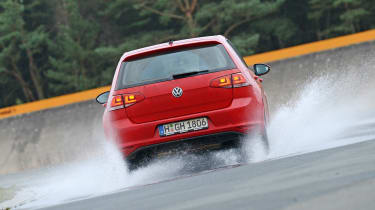We get more than our fair share of rain in Britain, and the problem only gets worse in winter. Not only does heavy rain reduce visibility and increase braking distances, but it also creates standing water, which can cause your car to aquaplane.
If you’ve ever experienced aquaplaning before, either from behind the wheel or the passenger seat, you’ll know it’s no laughing matter. That’s why it’s absolutely vital that you understand what you need to do if you find yourself aquaplaning and how you can prevent it in the first place. This guide explains everything you need to know.
What is Aquaplaning?
Aquaplaning is a relatively simple concept. It occurs when a layer of water forms between the surface of your car tyres and the road surface, breaking the contact between your tyres and the road. When a car starts aquaplaning its tyres lose contact with the road and the car stops responding to control inputs such as braking, steering and acceleration.
The grooves in your car tyres are designed to dissipate water that is on the road. If the volume of water on the road is greater than the volume of tread on your tyres, there will be a surplus of water that cannot be dissipated and the car can start to aquaplane.
If that isn’t enough, a surplus of water builds up in the front of the tyre and will reach a critical point. At this moment, the pressure from the water on the rubber will lift the tyre up, so that it is no longer in contact with the road and the car starts to aquaplane.
Aquaplaning predominantly affects the front wheels as the rears are usually trailing in the drier tracks left by the front tyres. This means that steering inputs will have no effect and, because a car’s brakes are biased to the front, the majority of braking capability will also be lost. Drive will also be removed if you are in a front-wheel-drive car. If all four wheels are separated from the tarmac during aquaplaning, you will be moments away from losing control of your vehicle.
What to do if aquaplaning happens?
For those who have not experienced aquaplaning before, it will take a second to realise what is happening but the tell tale signs are engine revs spiking (due to the reduced resistance required to make the wheels rotate) and the steering becoming much lighter (again, due to the reduced force required to turn the wheels).
As in so many situations, the worst thing you can do is panic. Mashing the brakes and twirling at the steering wheel will have little effect and could land you in far worse trouble if your car suddenly regains contact with the road.
What you should do is the following: If you are using cruise control, turn it off using the switch, using the brakes at this point may upset the balance of the car and put you in a spin. Then gently lift off the throttle. As your brakes, steering, and acceleration are currently redundant, the only sensible thing to do is simply let the car slow down naturally. As the speed drops gently try the steering and if it appears to be biting, move onto applying the brakes. Gradually you will be able to regain control of your car, before stopping and realising that you need to now breathe.
If your car does not slow sufficiently to regain control or you are fast approaching a corner, there is very little you can do aside from keep trying the steering and brakes ensuring each time you are gentle and smooth.
What can you do to prevent it from happening?
When your car starts aquaplaning you effectively become a passenger, so the best course of action is to prevent it happening in the first place.
There are a couple of golden rules to consider when trying to reduce the chances of aquaplaning happening. Firstly, be aware of the conditions. If there is standing water around or it starts to rain heavily, reduce your speed and take extra care to avoid patches of road that look to be waterlogged. Slowing down in wet conditions gives your tyres more chance to work, reduces any build-up of excess water and increases the amount of grip available.

After this, there is the condition of your tyres to take into account. Excessively worn, or damaged tyres are less efficient at dispersing water from the road, with an increasing drop off in a tyre’s performance as it approaches the minimum legal limit. Ensuring there is ample tread and that your tyres are inflated to the correct pressure goes a long way towards improving your safety. Even though the minimum legal requirement is 1.6mm, leading safety experts recommend a minimum of 2.5mm for winter driving and considering a set of winter tyres is another good idea.
If you can, it’s also worth using the tracks left by the car in front of you. There will be significantly less water for your tyres to remove here but you must always maintain a safe distance. In wet weather, stopping distances increase dramatically.
Do you think there is a greater hazard than aquaplaning? If so let us know in the comments section…
